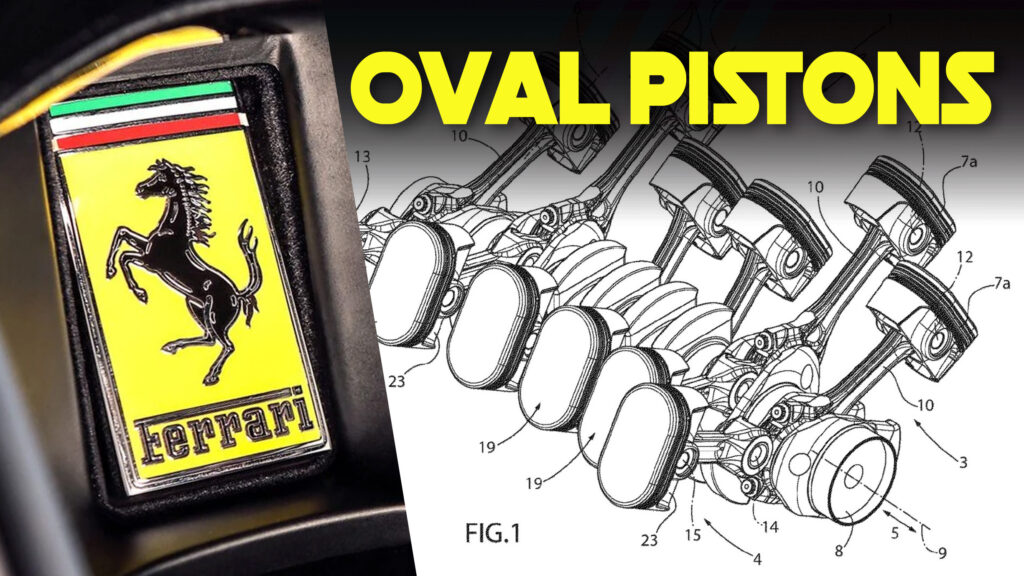
- Ferrari has filed a patent for an engine with oval-shaped pistons.
- The design shortens powertrain length without losing capacity.
- Honda unsuccessfully tried oval pistons in its racing motorcycles.
If you thought automakers had stopped putting effort into coming up with radical new combustion ideas as they shift their focus towards EVs, you’d be wrong. Ferrari has filed a patent for engines with pistons shaped like a classic Nascar track.
var adpushup = window.adpushup = window.adpushup || {que:[]};
adpushup.que.push(function() {
if (adpushup.config.platform !== “DESKTOP”){
adpushup.triggerAd(“0f7e3106-c4d6-4db4-8135-c508879a76f8”);
} else {
adpushup.triggerAd(“82503191-e1d1-435a-874f-9c78a2a54a2f”);
}
});
The patent unearthed by AutoGuide and filed last fall with the European Patent Office is for engines with “stadium-shape” pistons. That is to say they’re not strictly ovals, but are more like rectangles with the two short sides rounded.
Related: Ferrari Patents Sliding Cockpit, Allowing For LHD, RHD, And Central Driving Positions
The pistons are oriented so the longer edge runs from the outer side of the block to the inner vee, which would help reduce the length of an engine. That could be particularly useful if Ferrari was looking to add hybrid power without creating an extremely long powertrain. There could also be advantages for valve sizes (or the number of valves) fitted above each piston.
Although Ferrari’s patent only specifies the engine would have at least two cylinders, one of the drawings shows a V12. The new F80 hypercar disappointed some fans by only having a V6 (although this ties in with the brand’s F1 and Le Mans car tech), so maybe Ferrari is thinking about how to equip its successor with a compact hybrid V12.
Or maybe it’s thinking about how to manage the weight on its front-engined V12 cars, the 12Cilindri and Purosangue, neither of which currently have hybrid power, but will need it going forward.

Another interesting tech innovation contained in the patent filing concerns the conrods. Instead of each piston having its own connecting rod which bolts directly to the crankshaft, independently of the other pistons, the rods in this new engine are joined. The bearing cap on one rod is formed by the base of the opposite piston’s rod, a flexible joint allowing the second rod to swivel as required to move up and down the cylinder bore.
Motorcycle fans might know that Ferrari isn’t the first company to try to reimagine the piston. In the late 1970s Honda created a V4 with true oval pistons for its NR500 race bike in an attempt to build a four-stroke that could keep up with two strokes.
In that case the pistons were arranged with their longer side parallel, rather than perpendicular to the crankshaft, and each piston had two conrods. Honda’s engineers came up with the design to make room for eight valves per cylinder for better breathing but the engines suffered from ineffective piston ring sealing and never lived up to their promise.
var adpushup = window.adpushup = window.adpushup || {que:[]};
adpushup.que.push(function() {
if (adpushup.config.platform !== “DESKTOP”){
adpushup.triggerAd(“bb7964e9-07de-4b06-a83e-ead35079d53c”);
} else {
adpushup.triggerAd(“9b1169d9-7a89-4971-a77f-1397f7588751”);
}
});
H/T to AutoGuide
var adpushup = window.adpushup = window.adpushup || {que:[]};
adpushup.que.push(function() {
if (adpushup.config.platform !== “DESKTOP”){
adpushup.triggerAd(“bb7964e9-07de-4b06-a83e-ead35079d53c”);
} else {
adpushup.triggerAd(“9b1169d9-7a89-4971-a77f-1397f7588751”);
}
});